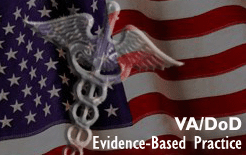 WASHINGTON (May 6, 2011) – Researchers from the Veterans Affairs (VA) and Department of Defense (DoD) have produced a new 56-page guidebook to spur more collaboration between the agencies on clinical health research. The VA-DoD Collaboration Guidebook for Healthcare Research, online at www.research.va.gov/va-dod, is filled with practical tips and information for researchers. It covers topics such as identifying collaborators, submitting research proposals, and understanding the rules for data security and human-subjects protection in each agency.
WASHINGTON (May 6, 2011) – Researchers from the Veterans Affairs (VA) and Department of Defense (DoD) have produced a new 56-page guidebook to spur more collaboration between the agencies on clinical health research. The VA-DoD Collaboration Guidebook for Healthcare Research, online at www.research.va.gov/va-dod, is filled with practical tips and information for researchers. It covers topics such as identifying collaborators, submitting research proposals, and understanding the rules for data security and human-subjects protection in each agency.
According to VA Chief Research and Development Officer Dr. Joel Kupersmith, the guidebook is a key step in ongoing efforts over the past two decades to increase VA-DoD collaboration, particularly in health care. Other initiatives have focused, for example, on sharing electronic medical records or building joint health care facilities.
“Collaboration is one of three guiding principles for the VA-DoD Joint Strategic Plan for 2009 – 2011,” said Kupersmith. “This new guidebook will make it easier for talented, innovative investigators from both agencies to work together on projects that advance the health and well-being of active duty personnel and Veterans.”
To date, researchers from VA and DoD have worked jointly on initiatives focused on post-traumatic stress disorder, traumatic brain injury, burn injuries, amputation and prosthetics, sensory loss, infectious disease, and many other issues. One prominent example of a joint effort is the high-tech DEKA prosthetic arm, developed through funding from the Defense Advanced Research Projects Agency and now being field tested with Veterans at several VA sites.
The new guidebook, funded by VA’s Health Services Research and Development Service, was created by six lead authors from VA and DoD and more than a dozen advisors and reviewers representing the two agencies.
Topics covered include techniques for finding collaborators with common research interests and goals; administrative and funding mechanisms in VA and DoD; types of formal agreements for collaborative projects; suggestions for developing and submitting proposals; and examples of both successful and unsuccessful research collaborations.
The guidebook also contains links to additional resources, and a comprehensive list of acronyms commonly used by researchers in both agencies, ranging from AAHRPP (Association for the Accreditation of Human Research Protection) to WRIISC (War Related Illness and Injury Study Center).
According to lead author Linda Resnik, a research scientist at the Providence VA Medical Center and associate professor at Brown University, “The guidebook is a living document that will need periodic updating so that it contains the most current and relevant content.” She said feedback and suggestions could be sent to [email protected].
ATTENTION READERS
We See The World From All Sides and Want YOU To Be Fully InformedIn fact, intentional disinformation is a disgraceful scourge in media today. So to assuage any possible errant incorrect information posted herein, we strongly encourage you to seek corroboration from other non-VT sources before forming an educated opinion.
About VT - Policies & Disclosures - Comment Policy



